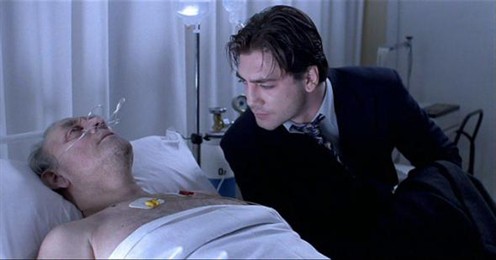
"El Detective y la Muerte" (The
Detective and Death) unfolds one night, in a mythical space that is
the reflection of our current world. A city in conflict, where each
character seeks sense through action, in the shadows, behind the
scenes of power and death.
I once read a fable by Andersen in
which a mother chases Death who had taken away her son; she
persists in her efforts to recover him. The story is sadistic and
symbolic. The mother goes through many difficulties before arriving
at the demons of Death....
"The Detective and Death" envisages a
journey that leads to a recognizable reality: power, corruption,
violence, death and, in contrast, characters who never give in and
influence events through their acts.
The difficulty in producing the movie
was how to reconvert the fantastic into something tangible for the
viewer to grasp...
The demons of death are a big Blue
House, along the shores of a lake, from where a powerful magnate
corrupts governments, traffics with drugs, weapons and human organs
as he disposes of lives according to his whims and
convenience.
We did the shooting at a palace, 50
kms away from Warsaw, where Walesa had been confined and which at
present is used for government meetings and receiving foreign
ambassadors. The light transformed the palace into the Blue House
and December, with temperatures of about 14 degrees Celsius below
zero, had frozen the surface of the lake.
The dream of power is to create an
artificial world to control it better and to perpetuate itself; a
dream of death, in its own image and likeness.
B.S., the powerful magnate, resorts to
a sophisticated toy of virtual reality to create the illusion of
immortality, just as his ancestors used statues for the same
purpose.
The greenhouse of the Blue House is
full of sculptures that compete with the artificial images which
the operator of the film obtained through the reflections on
glass.
The mother from Andersen's story goes
through a forest before arriving at the lake. In the film, the
forest is the city.
It occurred to me that the mother
should follow the steps of the detective, in her journey towards
death, and that the condition for recovering her son was the
exchange of one life for another...
An unknown world opens up before our
eyes and senses. That is the adventure. That is the
film.
A gunman harasses and lurks about, as
if he were the shadow of the detective, as planned by B.S., who
people nicknamed the ·Big Shit"; there is no sobriquet more
convincing than that to describe the word power.
The Duchess, beautiful and mature,
waits for the detective in a flat of the city where she is secluded
after being expelled from the Blue House. Her daughter, Laura, has
now taken her place in the arms and the bed of B.S.
Few films owe so much to the light as
"The Detective and Death", the action of which takes place in the
middle of the night; the light sculpts the darkness.
The mother's name is María (María de
Medeiros), the detective is called Cornelio (Javier Bardem), the
gunman is an Obscure Man (Carmelo Gómez), Charo López is the
Duchess, B.S. is B.S. (Héctor Alterio) and Laura (Mapi Galán) is a
spoiled and wicked young woman.
Everybody obeys the dictates of their
wishes, their passion is the law and the film's law is the cinema,
an imperious law nobody can elude when the imagined images, if
you'll forgive the repetition, connect with reality.
A reality which Maria is able to
disrupt with the power of her gaze and her innocence, the same
innocent look with which the viewer will watch the film from his
seat, to recover his breath.
That is the challenge of "The
Detective and Death," the detective and the cinema. It is a
challenge that was worthwhile because the movie is unique and
unrepeatable.
GONZALO SUÁREZ.